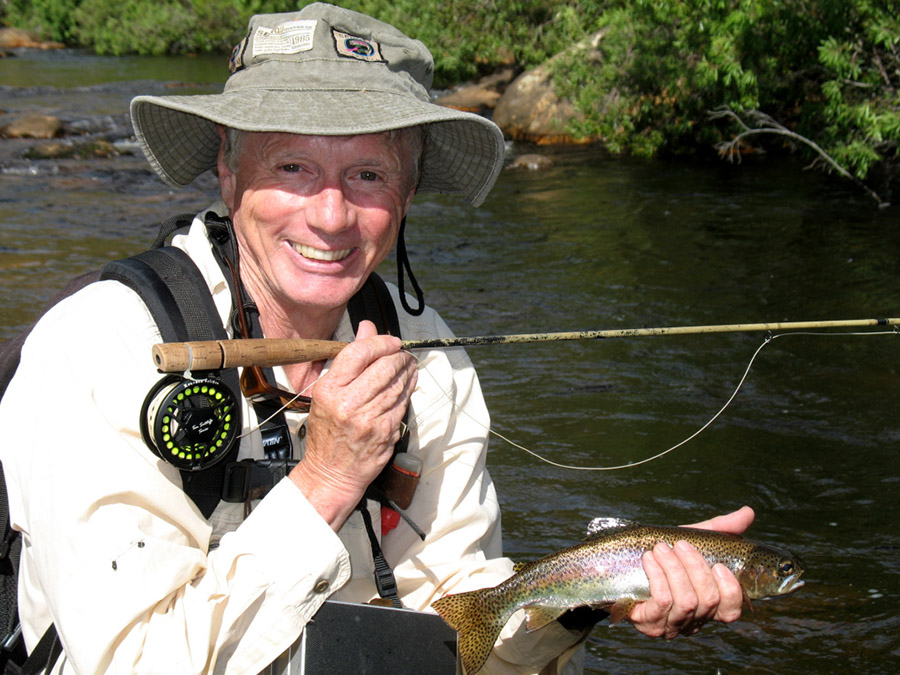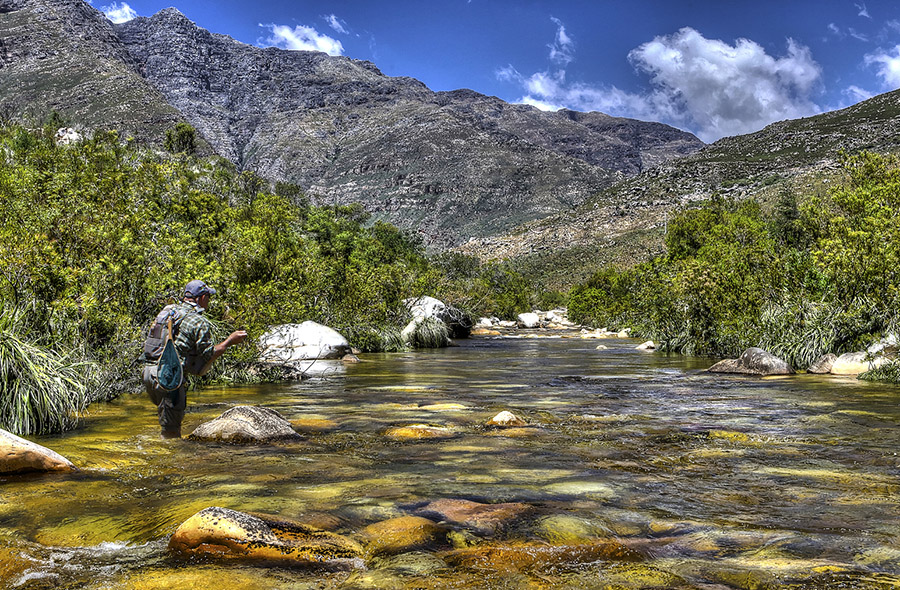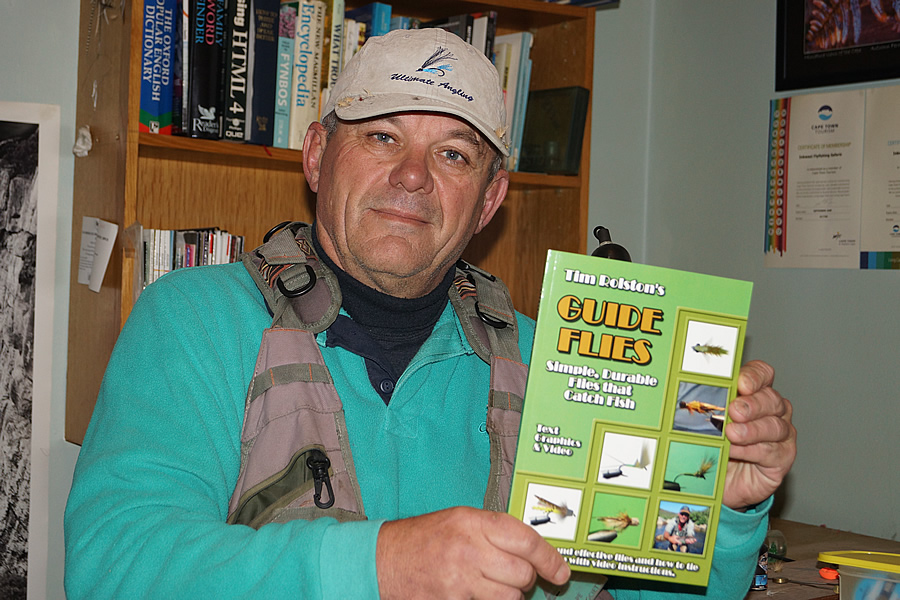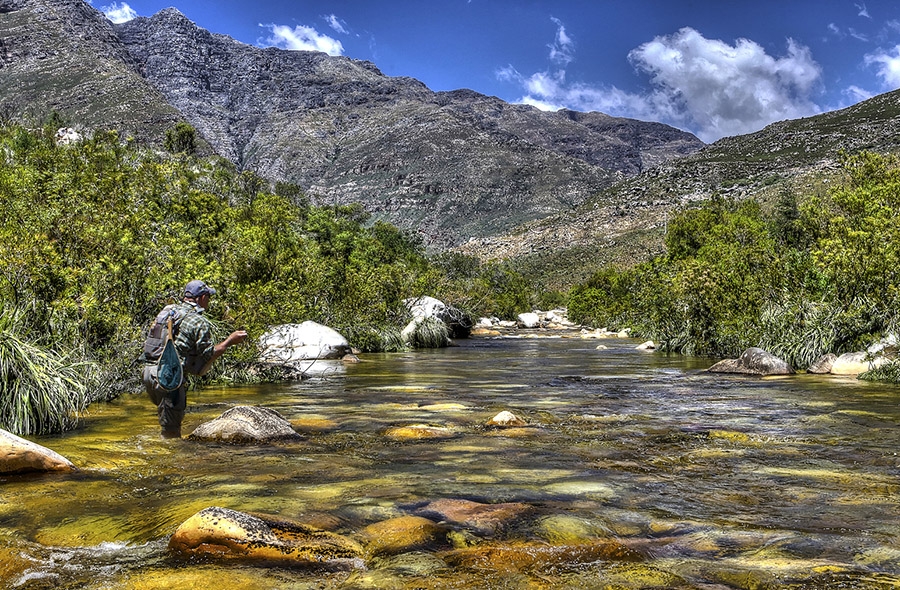While researching my recent article on the chronology of convex leaders I came across a few paragraphs in a book by Al McClane that I thought made a worthwhile contribution to the debate on whether tippets should float or sink.
When I could still fish, I visited the small mountain streams near Cape Town and I avoided the flat water because I found that stealthy wading was an oxymoron. Pocket water was far more forgiving and so I concentrated on such stretches of the stream.
Click in images to open them

The author concentrates on pocket water and greases his leader tippet down to the fly
In 1993 Tom Rosenbauer published Prospecting for Trout and he advocated greasing the leader right down to fly when fishing pocket water with dry flies. He said a) that it helped avoid drag because conflicting currents beneath the surface tugged the tippet this way and that, and b) if any part of the leader was sunk you were dragging your dry fly underwater on every back cast – which rather defeats the purpose of dry fly fishing. It therefore had nothing to do with whether or not the greased leader and tippet was more visible to the trout and thus more likely to frighten it.
This resonated with me because I believe one of the most fundamental and frequent mistakes that beginners make is that they rip the fly off the water on the back cast which puts a streak of white lightning across the trout’s living room ceiling.
To avoid this I started almost every cast with an abbreviated roll cast, sliding the line gently off the water into a delicate roll cast and then going into the back cast as the line unfolded over the water. You might argue that this was effectively putting the line over the fish twice, but my forward cast would extend the cast by a few feet and I found this a comforting way to fish that guaranteed a soft presentation.
Greasing the line with Mucilin right down to the tippet thus worked for me and it worked even more when I started using CDC flies which don’t react kindly to being drowned on every cast.
I was therefore cheered when Peter Hayes published his fascinating book, Fly Fishing Outside the Box – Emerging Heresies in 2013.
He said that the waterproof autofocus cameras which had just become available enabled him to see the leader and the tippet as trout see them
The idea of doing this was not new and he cites the experience of G E M Skues who used an underwater observation chamber constructed by the naturalist Dr Francis Ward. (A photograph can be seen in Paul Schullery’s, The Rise: Streamside Observations on Trout, Flies, and Fly Fishing).
In a footnote, Peter Hayes says: This business of sinking the tippet with which I so disagree has been handed down for decades, but actually only for a few of them. Skues, writing in The Way of a Trout with a Fly in 1921 (p 41) referring to what he had learned from looking up through the sunken window of Dr Francis Ward's experimental pond, said that when thrown on the surface dry, the gut was not noticeable from underneath except in the window, and not very noticeable then. Sunken gut he says 'became obvious', and goes on to say that 'the insistence of the dry fly angler on ... absolute dryness of gut and fly seems ... to be thoroughly justified.' So not only did Skues see the same as my camera, but he is clear that keeping your tippet floating was de rigueur up to the 1920s at least. Who was it that led us astray?
Tim Rolston, a professional fly fishing guide based in Cape Town and one of our most cerebral and experienced anglers was adamant that, in our bright sunshine, greasing the tippet was folly and, in this, he has the support of our most successful competitive fly fishers, such as M C Coetzer.
http://www.tomsutcliffe.co.za/fly-fishing/fly-tying/item/301-mc-coetzers-favourite-stream-patterns.html

Tim Rolston is adamant that in South Africa’s bright light, greased tippets are a disadvantage and lower the catch rate. He is seen here fishing the Molenaars River , Western Cape
Tim, whose combination of book and DVD, Guide Flies is absolutely outstanding and essential reading for small stream fly fishers in particular, wrote a typically incisive article on the question
https://paracaddis.wordpress.com/2013/08/13/should-tippets-float/
In further email correspondence Tim said: ‘I looked at your chronology and interesting reading there from highly tuned and well respected anglers. However I reiterate that in my opinion the sunk tippet is preferable. I am not so worried about the fish seeing the leader as seeing the shadow created by the deformation of the meniscus of the water. Truth be told very few anglers fish even a small amount of time in the sunny and clear water conditions which African anglers face on a daily basis. As such I am still more than happy to confirm that to me if there was one thing for which I might consider donating a limb or bodily organ it would undoubtedly be a consistent means of getting that tippet to sink.’

Tim with his book
Tippet sinkants - usually a mixture of Fuller’s Earth, dish washing liquid and a few drops of glycerine is another subject for another day but, as a contribution to this debate, I did an OCR scan on the relevant passages in the books by Rosenbauer and McClane:
Tom Rosenbauer: The Orvis Guide to Prospecting for Trout (Lyons Press, 2008) Pages 159 -160
'I originally started greasing my leader with silicone dry-fly paste because I had trouble following my fly in a pocket water stream that never seemed to see the sun. I found I could trace the fly better by looking for the shine of the leader on the water, and it didn’t bother the trout at all. Using a greasy leader in other streams because I was too lazy to change leaders or rub mud onto the fly to remove the silicone, I started noticing that drag wasn’t as much of a problem - I was getting longer floats. Switching back to a non-treated leader, I could see what was happening: The floating leader was far less affected by currents because it was riding half above the water instead of fully immersed in it. Would you fish a dry fly with a sinking line?
I still like to keep my leader sinking in smooth water, and often use fluorocarbon tippet, especially for the last five feet, because a leader’s shadow can disturb a nervous trout. But in riffled water, and in the smooth windows in pocket water where the trout don’t see much of your leader, it pays to keep the whole thing floating.’
Al McClane: The Practical Fly Fisherman, (Prentice Hall, 1975) Pages 80 – 81
'Whether a leader sinks or floats can be a worrisome question to the neophyte. While it is extremely important that the leader be rubbed perfectly straight, I doubt if it matters whether it sinks unless you are fishing a wet fly or nymph which requires that it go under. Traditionalists will raise a bloodshot eye at the idea that a floating leader is just as effective as one sunk below the surface, but I am convinced that trout see it one way or the other, and any attempt to hide it underwater is wasted effort. Trout will even hit the knots in a leader when they’re busy gorging on midges. To convince myself, I spent time in a wet suit with scuba gear studying the subject from the trout’s point of view; I only came to the conclusion that a sunken leader is more visible with its double image reflecting against the surface when it’s an inch or so under the water than a floating leader, which frankly I had more difficulty finding.
‘Leader shadow on the bottom is of no consequence because from the trout’s position, facing the current, his view of the river is horizontal and upward. To a fisherman standing in the water and looking down on the full length of it,the shadow may be alarming, but a trout has no such advantage. The important thing is that the leader makes it possible for an artificial fly to arrive on the stream like a natural insect. And to achieve that depends on how
smoothly you present your casts.’

Tim Rolston with a lovely brown trout from the clear waters of Smalblaar River Western Cape
In closing: As an historic footnote it is worth remembering that applying floatant dates from the time of G E M Skues although this tactic evolved as a means of detecting the take, almost a century before strike indicators became ubiquitous.
He called it the ‘Wet Fly Oil Tip and it involved the use of paraffin or Vaseline, by products of the burgeoning petroleum industry.
Here’s a link to a passage from The Way of a Trout with the Fly in which Skues discusses some of points raised in this chronology on greasing leaders and tippets.
http://www.forgottenbooks.com/readbook_text/The_Way_of_a_Trout_1000102691/203
Guide Flies and Tim’s other books are available for order on line in various formats from printed to downloadable files from http://www.inkwaziflyfishing.co.za/Inkwazi%20Bookshop.html



